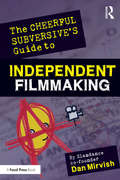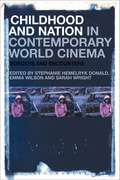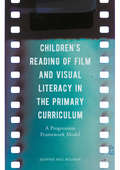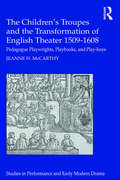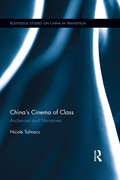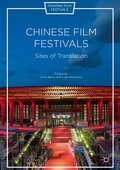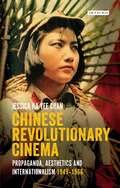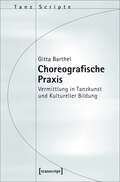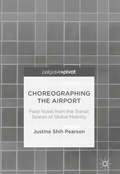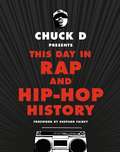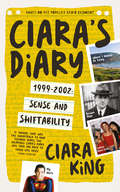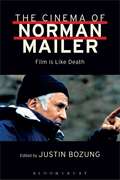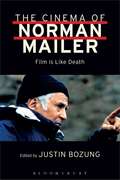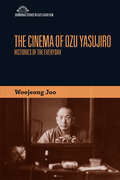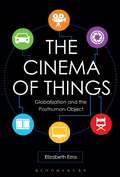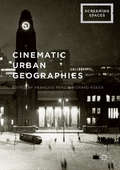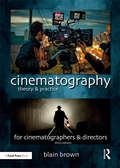- Table View
- List View
The Cheerful Subversive's Guide to Independent Filmmaking: From Preproduction to Festivals and Distribution
by Dan MirvishIn The Cheerful Subversive’s Guide to Independent Filmmaking, celebrated Slamdance Film Festival co-founder Dan Mirvish offers a rich exploration of the process and culture of making low-budget, independent films. Once labelled a "cheerful subversive" by The New York Times, Mirvish shares his unfiltered pragmatic approach to scriptwriting, casting, directing, producing, managing a crew, post-production, navigating the film festival circuit, distributing your film, dealing with piracy and building a career. Readers will learn how to game the Hollywood system to their advantage, get their films accepted by respected festivals without going broke, and utilize a broad range of media and tactics to promote and distribute their work. A companion website features behind-the-scenes interviews and footage from Dan’s films, and much more. Learn everything you need to know to make, promote, and distribute your independent films, with time-tested lessons and practical advice on scriptwriting, casting and directing A-list actors, financing, producing, managing a crew, editing in post, creating visual effects on a budget, and successuflly navigating the film festival circuit Find out what it takes to become a true "cheerful subversive" and adopt new and innovative approaches to producing your films, discover hidden loopholes in the Hollywood system and festival scene, take advantage of a broad range of media formats to promote and distribute your indie films, and generally make bold moves in service of your creative work, all while staying flexible enough to pivot at a moment’s notice An extensive companion website features in-depth interviews with filmmakers, more than an hour of behind-the-scenes footage from Dan Mirvish’s films, festival resources, and much more
The Cheerful Subversive's Guide to Independent Filmmaking: From Preproduction to Festivals and Distribution
by Dan MirvishIn The Cheerful Subversive’s Guide to Independent Filmmaking, celebrated Slamdance Film Festival co-founder Dan Mirvish offers a rich exploration of the process and culture of making low-budget, independent films. Once labelled a "cheerful subversive" by The New York Times, Mirvish shares his unfiltered pragmatic approach to scriptwriting, casting, directing, producing, managing a crew, post-production, navigating the film festival circuit, distributing your film, dealing with piracy and building a career. Readers will learn how to game the Hollywood system to their advantage, get their films accepted by respected festivals without going broke, and utilize a broad range of media and tactics to promote and distribute their work. A companion website features behind-the-scenes interviews and footage from Dan’s films, and much more. Learn everything you need to know to make, promote, and distribute your independent films, with time-tested lessons and practical advice on scriptwriting, casting and directing A-list actors, financing, producing, managing a crew, editing in post, creating visual effects on a budget, and successuflly navigating the film festival circuit Find out what it takes to become a true "cheerful subversive" and adopt new and innovative approaches to producing your films, discover hidden loopholes in the Hollywood system and festival scene, take advantage of a broad range of media formats to promote and distribute your indie films, and generally make bold moves in service of your creative work, all while staying flexible enough to pivot at a moment’s notice An extensive companion website features in-depth interviews with filmmakers, more than an hour of behind-the-scenes footage from Dan Mirvish’s films, festival resources, and much more
Child Actors on the London Stage, Circa 1600: Their Education, Recruitment and Theatrical Success
by Julie AckroydA legal document dated 1600, for a Star Chamber case titled Clifton versus Robinson, details how boys were abducted from London streets and forcibly held in order to train them as actors for the Blackfriars theatre. No adults were seen on-stage in this theatre, which was stocked solely by acting boys, resulting in a satirical and scurrilous method of play presentation. Were the boys specifically targeted for skills they may have possessed which would have been applicable to this type of play presentation? And, was this method of recruitment typical or atypical of Elizabethan theatre? Analysis of the background of the boy subjects of the legal case indicate that several had received grammar-school tuition and, as a result, would have possessed skills in oration and rhetoric. Indeed, a significant number of the grammar schools in London provided regular public disputations and theatrical performances which would have made these boys an attractive proposition for inclusion in a theatrical company. The styles of play-texts which the boys performed and their manner of presenting characters helps to assess why child acting companies were commercially viable and popular. Their portrayal of all roles in a performance; young and old, male and female, clearly demonstrated their versatility and skill in mimicry and the adoption of other personas. Therefore the taking of grammar-school boys for re-training as actors was not opportunistic; their abductions were planned. The theatre owners undertook this method of recruitment as they felt that they were immune from prosecution due to holding royal commissions which they used to recruit boys. However, the Clifton vs. Robinson case clearly demonstrates that a determined parent whose child had been taken could challenge this and demand reparation.
Childhood and Nation in Contemporary World Cinema: Borders and Encounters
by Sarah Wright Emma Wilson Stephanie Hemelryk DonaldThe child has existed in cinema since the Lumière Brothers filmed their babies having messy meals in Lyons, but it is only quite recently that scholars have paid serious attention to her/his presence on screen. Scholarly discussion is now of the highest quality and of interest to anyone concerned not only with the extent to which adult cultural conversations invoke the figure of the child, but also to those interested in exploring how film cultures can shift questions of agency and experience in relation to subjectivity. Childhood and Nation in World Cinema recognizes that the range of films and scholarship is now sufficiently extensive to invoke the world cinema mantra of pluri-vocal and pluri-central attention and interpretation. At the same time, the importance of the child in figuring ideas of nationhood is an undiminished tic in adult cultural and social consciousness. Either the child on film provokes claims on the nation or the nation claims the child. Given the waning star of national film studies, and the widely held and serious concerns over the status of the nation as a meaningful cultural unit, the point here is not to assume some extraordinary pre-social geopolitical empathy of child and political entity. Rather, the present collection observes how and why and whether the cinematic child is indeed aligned to concepts of modern nationhood, to concerns of the State, and to geo-political organizational themes and precepts.
Childhood and Nation in Contemporary World Cinema: Borders and Encounters
by Sarah Wright Emma Wilson Stephanie Hemelryk DonaldThe child has existed in cinema since the Lumière Brothers filmed their babies having messy meals in Lyons, but it is only quite recently that scholars have paid serious attention to her/his presence on screen. Scholarly discussion is now of the highest quality and of interest to anyone concerned not only with the extent to which adult cultural conversations invoke the figure of the child, but also to those interested in exploring how film cultures can shift questions of agency and experience in relation to subjectivity. Childhood and Nation in World Cinema recognizes that the range of films and scholarship is now sufficiently extensive to invoke the world cinema mantra of pluri-vocal and pluri-central attention and interpretation. At the same time, the importance of the child in figuring ideas of nationhood is an undiminished tic in adult cultural and social consciousness. Either the child on film provokes claims on the nation or the nation claims the child. Given the waning star of national film studies, and the widely held and serious concerns over the status of the nation as a meaningful cultural unit, the point here is not to assume some extraordinary pre-social geopolitical empathy of child and political entity. Rather, the present collection observes how and why and whether the cinematic child is indeed aligned to concepts of modern nationhood, to concerns of the State, and to geo-political organizational themes and precepts.
Children's Reading of Film and Visual Literacy in the Primary Curriculum: A Progression Framework Model
by Jeannie Hill BulmanThis book draws on a longitudinal study which highlights the beneficial impact of film in the primary curriculum. It provides detailed accounts of both the reading process as understood within the field of literacy education, and of film theory as it relates to issues such as narration, genre and audience. The book focuses on a small cohort of children to explore how progression in reading film develops throughout a child’s time in Key Stage 2; it also examines how the skills and understanding required to read film can support the reading of print, and vice versa, in an ‘asset model’ approach. Since children’s progression in reading film is found to be not necessarily age-related, but rather built on a period of experience and opportunity to read and/or create moving image media, Bulman clearly illustrates the importance of the inclusion of film in the primary curriculum. The book provides an accessible study to a large audience of primary teachers and practitioners, and will be a valuable resource for students and researchers in the fields of education, English and media studies.
Children's Reading of Film and Visual Literacy in the Primary Curriculum: A Progression Framework Model
by Jeannie Hill BulmanThis book draws on a longitudinal study which highlights the beneficial impact of film in the primary curriculum. It provides detailed accounts of both the reading process as understood within the field of literacy education, and of film theory as it relates to issues such as narration, genre and audience. The book focuses on a small cohort of children to explore how progression in reading film develops throughout a child’s time in Key Stage 2; it also examines how the skills and understanding required to read film can support the reading of print, and vice versa, in an ‘asset model’ approach. Since children’s progression in reading film is found to be not necessarily age-related, but rather built on a period of experience and opportunity to read and/or create moving image media, Bulman clearly illustrates the importance of the inclusion of film in the primary curriculum. The book provides an accessible study to a large audience of primary teachers and practitioners, and will be a valuable resource for students and researchers in the fields of education, English and media studies.
The Children's Troupes and the Transformation of English Theater 1509-1608: Pedagogue, Playwrights, Playbooks, and Play-boys (Studies in Performance and Early Modern Drama)
by Jeanne McCarthyThe Children’s Troupes and the Transformation of English Theater 1509–1608 uncovers the role of the children’s companies in transforming perceptions of authorship and publishing, performance, playing spaces, patronage, actor training, and gender politics in the sixteenth century. Jeanne McCarthy challenges entrenched narratives about popular playing in an era of revolutionary changes, revealing the importance of the children’s company tradition’s connection with many early plays, as well as to the spread of literacy, classicism, and literate ideals of drama, plot, textual fidelity, characterization, and acting in a still largely oral popular culture. By addressing developments from the hyper-literate school tradition, and integrating discussion of the children’s troupes into the critical conversation around popular playing practices, McCarthy offers a nuanced account of the play-centered, literary performance tradition that came to define professional theater in this period. Highlighting the significant role of the children’s company tradition in sixteenth-century performance culture, this volume offers a bold new narrative of the emergence of the London theater.
The Children's Troupes and the Transformation of English Theater 1509-1608: Pedagogue, Playwrights, Playbooks, and Play-boys (Studies in Performance and Early Modern Drama)
by Jeanne McCarthyThe Children’s Troupes and the Transformation of English Theater 1509–1608 uncovers the role of the children’s companies in transforming perceptions of authorship and publishing, performance, playing spaces, patronage, actor training, and gender politics in the sixteenth century. Jeanne McCarthy challenges entrenched narratives about popular playing in an era of revolutionary changes, revealing the importance of the children’s company tradition’s connection with many early plays, as well as to the spread of literacy, classicism, and literate ideals of drama, plot, textual fidelity, characterization, and acting in a still largely oral popular culture. By addressing developments from the hyper-literate school tradition, and integrating discussion of the children’s troupes into the critical conversation around popular playing practices, McCarthy offers a nuanced account of the play-centered, literary performance tradition that came to define professional theater in this period. Highlighting the significant role of the children’s company tradition in sixteenth-century performance culture, this volume offers a bold new narrative of the emergence of the London theater.
China's Cinema of Class: Audiences and Narratives (Routledge Studies on China in Transition)
by Nicole TalmacsChina’s commercial film industry can be used as a map to understand how class is interwoven into the imaginations that inform and influence social change in Chinese society. Film consumption is important in this process, particularly for young adult urbanites that are China’s primary commercial cinema patrons. This book investigates the web between the representation of class themes in Chinese film narratives, local audience reception to these films, and the socialisation of China’s contemporary class society. Bringing together textual analyses of narratives from five commercially exhibited films: Let the Bullets Fly (Jiang: 2010), Lost on Journey (Yip: 2011), Go Lala Go! (Xu: 2011), House Mania (Sun: 2011) and The Piano in the Factory (Zheng: 2011); and the reception of 179 Chinese audiences from varying class positions, it investigates the extent to which fictional narratives inform and reflect current class identities in present-day China. Through group discussions in Beijing, Hangzhou, Nanjing, Lanzhou and Taiyuan, the author searches for audiences beyond major cities that are typically the focus of film consumption studies in China. As such, the book reveals not only how deeply and widespread the socialisation of China’s class society has become in the imaginations of Chinese audiences, but also what appears to be a preference of both audiences and filmmakers for the continuation of China’s new class society. Revealing the extent to which cinema continues to play a key role in the socialisation of class structures in contemporary Chinese society, this book will be important for students and scholars of Chinese Studies, Film Studies, Communication Studies, as well as observers of China’s film industry.
China's Cinema of Class: Audiences and Narratives (Routledge Studies on China in Transition)
by Nicole TalmacsChina’s commercial film industry can be used as a map to understand how class is interwoven into the imaginations that inform and influence social change in Chinese society. Film consumption is important in this process, particularly for young adult urbanites that are China’s primary commercial cinema patrons. This book investigates the web between the representation of class themes in Chinese film narratives, local audience reception to these films, and the socialisation of China’s contemporary class society. Bringing together textual analyses of narratives from five commercially exhibited films: Let the Bullets Fly (Jiang: 2010), Lost on Journey (Yip: 2011), Go Lala Go! (Xu: 2011), House Mania (Sun: 2011) and The Piano in the Factory (Zheng: 2011); and the reception of 179 Chinese audiences from varying class positions, it investigates the extent to which fictional narratives inform and reflect current class identities in present-day China. Through group discussions in Beijing, Hangzhou, Nanjing, Lanzhou and Taiyuan, the author searches for audiences beyond major cities that are typically the focus of film consumption studies in China. As such, the book reveals not only how deeply and widespread the socialisation of China’s class society has become in the imaginations of Chinese audiences, but also what appears to be a preference of both audiences and filmmakers for the continuation of China’s new class society. Revealing the extent to which cinema continues to play a key role in the socialisation of class structures in contemporary Chinese society, this book will be important for students and scholars of Chinese Studies, Film Studies, Communication Studies, as well as observers of China’s film industry.
Chinese Film Festivals: Sites of Translation (Framing Film Festivals)
by Chris Berry Luke RobinsonThis book is the first anthology of research devoted to the booming world of Chinese film festivals, covering both mainstream and independent films. It also explores festivals in the Chinese-speaking world and festivals of Chinese films in the rest of the world. The book asks how Chinese film festivals function as sites of translation, translating Chinese culture to the world and world culture to Chinese-speaking audiences, and also how the international film festival model is being transformed as it is translated into the Chinese-speaking world.
Chinese Revolutionary Cinema: Propaganda, Aesthetics and Internationalism 1949–1966 (International Library of the Moving Image (PDF) #48)
by Jessica Ka ChanEngaging with fiction films devoted to heroic tales from the decade and a half between 1949 and 1966, this book reconceives state propaganda as aesthetic experiments that not only radically transformed acting, cinematography and screenwriting in socialist China, but also articulated a new socialist film theory and criticism. Rooted in the interwar avant-garde and commercial cinema, Chinese revolutionary cinema, as a state cinema for the newly established People's Republic, adapted Chinese literature for the screen, incorporated Hollywood narration, appropriated Soviet montage theory and orchestrated a new, glamorous, socialist star culture. In the wake of decolonisation, Chinese film journals were quick to project and disseminate the country's redefined self-image to Asia, Africa and Latin America as they helped to create an alternative vision of modernity and internationalism. Revealing the historical contingency of the term 'propaganda', Chan uncovers the visual, aural, kinaesthetic, sexual and ideological dynamics that gave rise to a new aesthetic of revolutionary heroism in world cinema. Based on extensive archival research, this book's focus on the distinctive rhetoric of post-war socialist China will be of value to East Asian Cinema scholars, Chinese Studies academics and those interested in the history of twentieth-century socialist culture.
Choreografische Praxis: Vermittlung in Tanzkunst und Kultureller Bildung (TanzScripte #45)
by Gitta BarthelVermittlung, Tanzkunst und Kulturelle Bildung stehen in engem Zusammenhang. Gitta Barthel stellt künstlerisch-kulturelle Projekte vor, in denen Choreograf_innen mit heterogenen Gruppen arbeiten. Sie erschließt Vermittlung als immanenten Bestandteil von Choreografie und liefert eine faszinierende Zusammenstellung von Vermittlungspraktiken und Aufmerksamkeitslenkungen. Theoretische Ausgangspunkte bilden die tanzwissenschaftliche Reflexion zu Praktiken des erweiterten Choreografiebegriffes und die Betrachtung des Bedingungsgefüges gegenwärtiger Tanzvermittlung aus der Perspektive des Kreativitätsdispositivs. Die in der praxeologischen Tanzwissenschaft verortete Studie trägt Erkenntnisse zur Tanzpädagogik ebenso wie zur Kulturellen Bildung bei.
Choreographing the Airport: Field Notes from the Transit Spaces of Global Mobility (PDF)
by Justine Shih PearsonThis book investigates the global hub airport as an exemplar of cosmopolitan culture and space. A machine made for movement, itself perched at the crossroads of the world’s incessant mobility, the airport is both a symbol of and stage for the ways in which we construct and inhabit the world today.Taking an ethnographically-inflected approach, this study brings together knowledge of the moving body from dance and performance and the study of systems of mobility within cultural and mobilities studies, in order to call attention to the kinaesthetic experience of global space. What is the choreography of the global airport? How does it perform on us. How do we perform within it?Extending thinking about contemporary cosmopolitanism and cultural identity, and the performativity of places and identities, this book is essential reading for those interested in cultural debates around globalisation, the innovative application of performance theory towards everyday experience, and interdisciplinary methodologies.
Chuck D Presents This Day in Rap and Hip-Hop History
by Chuck DA one-of-a kind survey of rap and hip hop history from 1973 to today by Chuck D, arguably the most influential rapper in the world.In the more than 40 years since the days of DJ Kool Herc and "Rapper's Delight," hip hop and rap have become a billion-dollar worldwide phenomenon. Yet there is no definitive history of the genre-until now.Based on Chuck's long-running show on Rapstation.com, this massive compendium details the most iconic moments and influential songs in the genre's recorded history, from Kurtis Blow's "Christmas Rappin'" to The Miseducation of Lauryn Hill to Kendrick Lamar's ground-breaking verse on "Control." Also included are key events in hip hop history, from Grandmaster Flash's first scratch through Tupac's holographic appearance at Coachella.Throughout, Chuck offers his insider's perspective on the chart toppers and show stoppers as he lived it. Illustrating the pages are more than 100 portraits from the talented artists specializing in hip hop.
Ciara's Diary: 1999-2002: Sense and Shiftability
by Ciara KingThe year is 1999. Connemara is braced for the new millennium. ‘No Scrubs’ rules the airwaves, bootleg DVDs of Cruel Intentions are thrilling crowds of sexually progressive teens, and if you’re not matching combat trousers with platforms, you are nobody.In the midst of this perplexing world, a girl named Ciara, inspired by her heroes Anne Frank and Aung San Suu Kyi, begins to document her not dissimilar struggles – against pushy parents, mysterious boys and the stubborn non-appearance of boobs. The road ahead will be tough, but she must persevere: How else will she find fame, fortune and love in the spandex-clad arms of Dean Cain?Based on the cult radio segment of the same name, Ciara’s Diary is a fresh and funny trip through the warped mind of a turn-of-the-century teenager. The spiritual successor to Adrian Mole, albeit with more shifting, Ciara’s Diary is a must-read for anyone who remembers dancing to ‘Maniac 2000’ at the parish disco.
The Cinema of Norman Mailer: Film is Like Death
by Norman Mailer Justin BozungThe Cinema of Norman Mailer: Film is Like Death not only examines the enfant terrible writer's thoughts on cinema, but also features interviews with Norman Mailer himself. The Cinema of Norman Mailer also explores Mailer's cinema through previously published and newly commissioned essays written by an array of film and literary scholars, enthusiasts, and those with a personal, philosophical connection to Mailer. This volume discusses the National Book Award and Pulitzer Prize-winning author and filmmaker's six films created during the years of 1947 and 1987, and contends to show how Mailer's films can be best read as cinematic delineations that visually represent many of the writer's metaphysical and ontological concerns and ideas that appear in his texts from the 1950s until his passing in 2007. By re-examining Mailer's cinema through these new perspectives, one may be awarded not just a deeper understanding of Mailer's desire to make films, but also find a new, alternative vision of Mailer himself. Norman Mailer was not just a writer, but more: he was one of the most influential Postmodern artists of the twentieth century with deep roots in the cinema. He allowed the cinema to not only influence his aesthetic approach, but sanctioned it as his easiest-crafted analogy for exploring sociological imagination in his writing. Mailer once suggested, "Film is legitimately more interesting than books..." and with that in mind, readers of Norman Mailer might begin to rethink his oeuvre through the viewfinder of the film medium, as he was equally as passionate about working within cinema as he was about literature itself.
The Cinema of Norman Mailer: Film is Like Death
by Norman Mailer Justin BozungThe Cinema of Norman Mailer: Film is Like Death not only examines the enfant terrible writer's thoughts on cinema, but also features interviews with Norman Mailer himself. The Cinema of Norman Mailer also explores Mailer's cinema through previously published and newly commissioned essays written by an array of film and literary scholars, enthusiasts, and those with a personal, philosophical connection to Mailer. This volume discusses the National Book Award and Pulitzer Prize-winning author and filmmaker's six films created during the years of 1947 and 1987, and contends to show how Mailer's films can be best read as cinematic delineations that visually represent many of the writer's metaphysical and ontological concerns and ideas that appear in his texts from the 1950s until his passing in 2007. By re-examining Mailer's cinema through these new perspectives, one may be awarded not just a deeper understanding of Mailer's desire to make films, but also find a new, alternative vision of Mailer himself. Norman Mailer was not just a writer, but more: he was one of the most influential Postmodern artists of the twentieth century with deep roots in the cinema. He allowed the cinema to not only influence his aesthetic approach, but sanctioned it as his easiest-crafted analogy for exploring sociological imagination in his writing. Mailer once suggested, "Film is legitimately more interesting than books..." and with that in mind, readers of Norman Mailer might begin to rethink his oeuvre through the viewfinder of the film medium, as he was equally as passionate about working within cinema as he was about literature itself.
The Cinema of Ozu Yasujiro: Histories of the Everyday (Edinburgh Studies in East Asian Film)
by Woojeong JooOne of the most well regarded of non-Western film directors, responsible for acknowledged classics like Tokyo Story (1953), Ozu Yasujiro worked during a period of immense turbulence for Japan and its population. This book offers a new interpretation of Ozu’s career, from his earliest work in the 1920s up to his death in 1963, focusing on Ozu’s depiction of the everyday life and experiences of ordinary Japanese people during a time of depression, war and economic resurgence. Firmly situating him within the context of the Japanese film industry, Woojeong Joo examines Ozu’s work as a studio director and his relation to sound cinema, and looks in-depth at his wartime experiences and his adaptation to postwar Japanese society. Drawing on Japanese materials not previously examined in western scholarship, this is a groundbreaking new study of a master of cinema.
The Cinema of Ozu Yasujiro: Histories of the Everyday (Edinburgh Studies in East Asian Film)
by Woojeong JooOne of the most well regarded of non-Western film directors, responsible for acknowledged classics like Tokyo Story (1953), Ozu Yasujiro worked during a period of immense turbulence for Japan and its population. This book offers a new interpretation of Ozu’s career, from his earliest work in the 1920s up to his death in 1963, focusing on Ozu’s depiction of the everyday life and experiences of ordinary Japanese people during a time of depression, war and economic resurgence. Firmly situating him within the context of the Japanese film industry, Woojeong Joo examines Ozu’s work as a studio director and his relation to sound cinema, and looks in-depth at his wartime experiences and his adaptation to postwar Japanese society. Drawing on Japanese materials not previously examined in western scholarship, this is a groundbreaking new study of a master of cinema.
The Cinema of Things: Globalization and the Posthuman Object
by Elizabeth EzraThis book explores the border zones between life and non-life as represented in cinema from the end of the nineteenth century, when France led the global film industry, to the first decades of the twenty-first century, when world film markets are dominated by Hollywood. Informed by both the Internet of Things and the Parliament of Things, The Cinema of Things examines cinematic depictions of the ways in which human beings are prosthetically engaged with life beyond the self in the global age: by hyperconsumption; by structures of racial and sexual objectification that reduce people designated as "others†? to objects of fascination, sexual gratification, warfare, or labor; and by information technology that replaces human agency with encoding. Consumer culture, a key feature of globalization, posits that we must supplement ourselves with commodities without which we would otherwise be incomplete: but these prostheses, rather than enhancing us, end up creating the insufficiencies they were meant to overcome. We are engulfed by objects, to the extent that we ourselves are becoming objectified. At the same time, objects, especially technological objects, are becoming increasingly autonomous, assuming roles that were once the preserve of human agency. We are becoming the objects of globalization, and cinema imaginatively represents this transformation, but it also offers us the possibility of retaining our humanity in the process.
The Cinema of Things: Globalization and the Posthuman Object
by Elizabeth EzraThis book explores the border zones between life and non-life as represented in cinema from the end of the nineteenth century, when France led the global film industry, to the first decades of the twenty-first century, when world film markets are dominated by Hollywood. Informed by both the Internet of Things and the Parliament of Things, The Cinema of Things examines cinematic depictions of the ways in which human beings are prosthetically engaged with life beyond the self in the global age: by hyperconsumption; by structures of racial and sexual objectification that reduce people designated as “others” to objects of fascination, sexual gratification, warfare, or labor; and by information technology that replaces human agency with encoding. Consumer culture, a key feature of globalization, posits that we must supplement ourselves with commodities without which we would otherwise be incomplete: but these prostheses, rather than enhancing us, end up creating the insufficiencies they were meant to overcome. We are engulfed by objects, to the extent that we ourselves are becoming objectified. At the same time, objects, especially technological objects, are becoming increasingly autonomous, assuming roles that were once the preserve of human agency. We are becoming the objects of globalization, and cinema imaginatively represents this transformation, but it also offers us the possibility of retaining our humanity in the process.
Cinematic Urban Geographies (Screening Spaces)
by Richard Koeck François PenzThis book proposes new methodological tools and approaches in order to tease out and elicit the different facets of urban fragmentation through the medium of cinema and the moving image, as a contribution to our understanding of cities and their topographies. In doing so it makes a significant contribution to the literature in the growing field of cartographic cinema and urban cinematics, by charting the many trajectories and points of contact between film and its topographical context. Under the influence of new technologies, the opening and the availability of previously unexplored archives but also the contribution of new scholars with novel approaches in addition to new work by experienced academics, Cinematic Urban Geographies demonstrates how we can reread the cinematic past with a view to construct the urban present and anticipate its future.
Cinematography: Image Making for Cinematographers and Directors
by Blain BrownThe world of cinematography has changed more in the last few years than it has since it has in 1929, when sound recording was introduced. New technology, new tools and new methods have revolutionized the art and craft of telling stories visually. While some aspects of visual language, lighting and color are eternal, shooting methods, workflow and cameras have changed radically. Even experienced film artists have a need to update and review new methods and equipment. These change affect not only the director of photography but also the director, the camera assistants, gaffers, and digital imaging technicians. Cinematography: Theory and Practice covers both the artistry and craftsmanship of cinematography and visual storytelling. Few art forms are as tied to their tools and technology as is cinematography. Take your mastery of these new tools, techniques, and roles to the next level with this cutting-edge roadmap from author and filmmaker Blain Brown. Whether you are a student of filmmaking, just breaking into the business, currently working in the industry and looking to move up to the next level, or an experienced professional who wants to update their knowledge of tools and techniques, this book provides both a basic introduction to these issues as well as more advanced and in-depth coverage of the subject. The companion website features additional material, including lighting demonstrations, basic methods of lighting, using diffusion and other topics. Topics Include: Visual language Visual storytelling Continuity and coverage Cameras and digital sensors Exposure techniques for film and video Color in-depth Understanding digital images Waveform monitors, vectorscopes, and test charts Using linear, gamma, and log encoded video Image control and grading on the set The tools and basics of film lighting ASC-CDL, ACES and other new methods Optics and focus Camera movement Set operations Green screen, high speed and other topics
